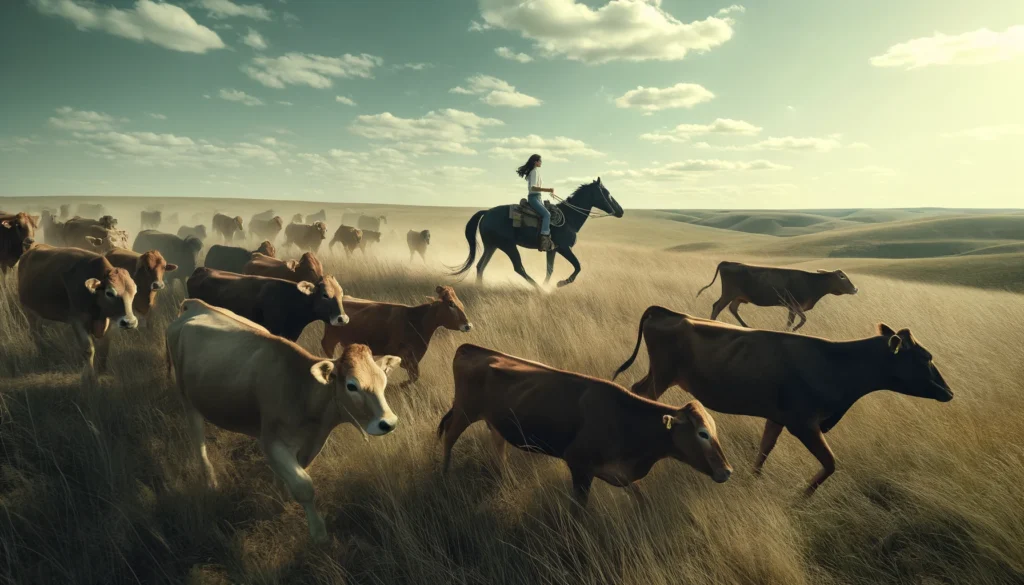
Pussycat Ranch A photorealistic wide aspect image of a female rancher in Texas standing in a vast field. She is wearing a cowboy hat a plaid shirt jeans and boots2.webp.jpeg
Empowerment Guide for Female Cattle Ranch Owners and Operators
13. Navigating Market Fluctuations and Risks
Understanding Market Trends
Staying informed about market trends and fluctuations is crucial for making informed decisions. Market conditions can impact cattle prices, feed costs, and overall profitability. Regularly reviewing market reports, subscribing to agricultural news sources, and joining industry forums can help female ranchers stay updated on market trends.
Risk Management Strategies
Risk management is a vital component of ranching. Implementing strategies such as diversification, forward contracting, and insurance can mitigate risks associated with market fluctuations, weather conditions, and other uncertainties. Programs like the USDA’s Livestock Risk Protection (LRP) insurance can offer financial protection against declining market prices.
14. Enhancing Soil Health and Pasture Management
Importance of Soil Health
Healthy soil is the foundation of successful ranching. It supports plant growth, improves water retention, and enhances the overall ecosystem. Female ranchers can prioritize soil health by conducting regular soil tests, using organic fertilizers, and implementing crop rotation practices.
Effective Pasture Management
Effective pasture management involves optimizing grazing patterns, maintaining proper stocking rates, and implementing rotational grazing. These practices can improve forage quality, prevent overgrazing, and support sustainable livestock production. Utilizing tools like grazing charts and mobile apps can help manage pastures more efficiently.
15. Embracing Diversity in Ranching
Celebrating Diverse Perspectives
Embracing diversity in ranching means recognizing and celebrating the unique perspectives and contributions of female ranchers from different backgrounds. Diversity enhances creativity, fosters innovation, and strengthens community ties. Female ranchers can lead by example, promoting inclusivity and supporting fellow women in the industry.
Addressing Challenges Faced by Minority Women
Minority women in ranching may face additional challenges, including discrimination and limited access to resources. Providing targeted support, creating mentorship programs, and advocating for policies that promote equity can help address these challenges. Building alliances with organizations that support minority women in agriculture can also offer valuable resources and support.
16. Leveraging Educational Resources
Formal Education and Training Programs
Formal education and training programs provide valuable knowledge and skills for ranching. Many universities and colleges offer agricultural programs with courses in livestock management, business administration, and sustainable practices. Scholarships and grants specifically for women in agriculture can make these programs more accessible.
Continuing Education and Workshops
Continuing education through workshops, webinars, and seminars can help female ranchers stay current with industry advancements. Organizations like the American Society of Agronomy and the National Sustainable Agriculture Coalition offer various educational resources and events. Participating in these opportunities can enhance skills and knowledge, leading to improved ranch management.
17. Building Strong Community Relationships
Engaging with Local Communities
Building strong relationships with local communities can benefit female ranchers in numerous ways. Community support can provide a market for products, offer networking opportunities, and create a sense of belonging. Engaging with local schools, participating in community events, and collaborating with local businesses can strengthen these ties.
Networking with Other Ranchers
Networking with other ranchers, both locally and nationally, can provide support, share knowledge, and foster collaboration. Joining ranching associations, attending conferences, and participating in online forums can facilitate these connections. Peer support can be invaluable in navigating challenges and celebrating successes.
18. Innovative Marketing and Sales Strategies
Direct-to-Consumer Sales
Direct-to-consumer sales can enhance profitability by cutting out intermediaries and creating a personal connection with customers. Farmers’ markets, on-farm stores, and online sales platforms are effective ways to reach consumers directly. Building a loyal customer base through quality products and excellent customer service is key.
Value-Added Products
Creating value-added products, such as artisanal cheeses, grass-fed beef, or handmade leather goods, can increase revenue and attract niche markets. Developing unique, high-quality products that reflect the ranch’s values and story can set it apart from competitors. Investing in branding and marketing these products effectively can drive sales.
19. Utilizing Data and Analytics
Data-Driven Decision Making
Data and analytics play a critical role in modern ranching. By collecting and analyzing data on cattle health, pasture conditions, and financial performance, ranchers can make informed decisions. Tools like Ranchr, AgriWebb, and FarmLogs provide comprehensive data management solutions tailored for ranching.
Monitoring Key Performance Indicators (KPIs)
Monitoring key performance indicators (KPIs) helps track the progress and success of ranching operations. Common KPIs include calving rates, weight gain, feed efficiency, and financial metrics. Regularly reviewing these indicators can identify areas for improvement and guide strategic planning.
20. Sustainable and Ethical Meat Production
Meeting Consumer Demands
Consumers are increasingly concerned about the sustainability and ethics of their food sources. Female ranchers can meet these demands by adopting humane animal handling practices, implementing environmentally friendly practices, and promoting transparency. Certifications such as Certified Humane, Animal Welfare Approved, and USDA Organic can provide credibility and attract conscientious consumers.
Storytelling and Transparency
Sharing the story behind the ranch, including its history, practices, and values, can build trust and loyalty with consumers. Transparency in operations, such as providing farm tours, detailed product information, and open communication, can further strengthen consumer relationships. Social media, blogs, and newsletters are effective platforms for storytelling.
Conclusion
Female cattle ranch owners and operators are making significant strides in an industry that has long been male-dominated. By leveraging resources, embracing innovation, and fostering supportive networks, women in ranching can overcome challenges and achieve remarkable success. This guide aims to provide practical advice, inspiration, and support to empower female ranchers, ensuring a vibrant and sustainable future for the industry.
How This Guide Helps Farmers
This continuation of the guide provides female cattle ranch owners and operators with detailed strategies for navigating market fluctuations, enhancing soil health, embracing diversity, leveraging educational resources, building community relationships, and utilizing innovative marketing and sales techniques. By focusing on data-driven decision-making and sustainable practices, it aims to support the growth and empowerment of women in the cattle ranching industry.

Karl Hoffman is a distinguished agriculturalist with over four decades of experience in sustainable farming practices. He holds a Ph.D. in Agronomy from Cornell University and has made significant contributions as a professor at Iowa State University. Hoffman’s groundbreaking research on integrated pest management and soil health has revolutionized modern agriculture. As a respected farm journalist, his column “Field Notes with Karl Hoffman” and his blog “The Modern Farmer” provide insightful, practical advice to a global audience. Hoffman’s work with the USDA and the United Nations FAO has enhanced food security worldwide. His awards include the USDA’s Distinguished Service Award and the World Food Prize, reflecting his profound impact on agriculture and sustainability.






Why did the cow go to space? To see the moooon!